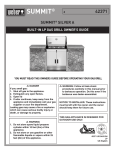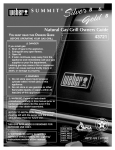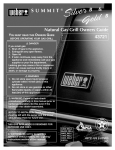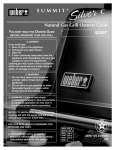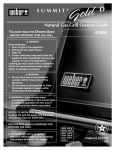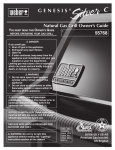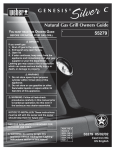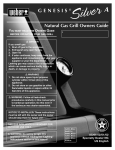Download Weber 42373 Owner`s manual
Transcript
SUMMIT® 42373 # SUMMIT® SILVER A BUILT-IN NATURAL GAS GRILL OWNER'S GUIDE YOU MUST READ THIS OWNERS GUIDE BEFORE OPERATING YOUR GAS GRILL DANGER If you smell gas: 1. Shut off gas to the appliance. 2. Extinguish any open flames. 3. Open lid 4. If odor continues, keep away from the appliance and immediately call your gas supplier or your fire department. Leaking gas may cause a fire or explosion which can cause serious bodily injury or death, or damage to property. WARNING 1. Do not store spare liquid propane cylinder within 10 feet (3m) of this appliance. 2. Do not store or use gasoline or other flammable liquids or vapors within 25 feet (8m) of this appliance. WARNING: Follow all leak-check procedures carefully in this manual prior to barbecue operation. Do this even if the barbecue was dealer-assembled. NOTICE TO INSTALLER: These instructions must be left with the owner and the owner should keep them for future use. THIS GAS APPLIANCE IS DESIGNED FOR OUTDOOR USE ONLY. 42373 US 04/01/04 NG US English DANGERS & WARNINGS DANGER Failure to follow the Dangers, Warnings and Cautions contained in this Owner’s Manual may result in serious bodily injury or death, or in a fire or an explosion causing damage to property. WARNINGS Do not store a spare or disconnected liquid propane cylinder under or near this barbecue. Improper assembly may be dangerous. Please carefully follow the assembly instructions in this manual. After a period of storage, and/or nonuse, the Weber® gas barbecue should be checked for gas leaks and burner obstructions before use. See instructions in this manual for correct procedures. Do not operate the Weber® gas barbecue if there is a gas leak present. Do not use a flame to check for gas leaks. Combustible materials should never be within 24 inches of the top, bottom, back or sides of your Weber® gas barbecue. Do not put a barbecue cover or anything flammable on, or in the storage area under the barbecue. Your Weber® gas barbecue should never be used by children. Accessible parts of the barbecue may be very hot. Keep young children away while it is in use. You should exercise reasonable care when operating your Weber® gas barbecue. It will be hot during cooking or cleaning and should never be left unattended, or moved while in operation. Should the burners go out while in operation, turn all gas valves off. Open the lid and wait five minutes before attempting to relight, using the lighting instructions. Do not use charcoal or lava rock in your Weber® gas barbecue. Never lean over open grill or place hands or fingers on the front edge of the cooking box. Should a grease fire occur, turn off all burners and leave lid closed until fire is out. Do not enlarge valve orifices or burner ports when cleaning the valves or burners. The Weber® gas barbecue should be thoroughly cleaned on a regular basis. Liquid propane gas is not natural gas. The conversion or attempted use of natural gas in a liquid propane unit or liquid propane gas in a natural gas unit is dangerous and will void your warranty. Do not attempt to disconnect any gas fitting while your barbecue is in operation. Use heat-resistant barbecue mitts or gloves when operating barbecue. Keep any electrical supply cord and the fuel supply hose away from any heated surfaces. Combustion byproducts produced when using this product contain chemicals known to the state of California to cause cancer, birth defects, or other reproductive harm. Do not use this barbecue unless all parts are in place. The unit must be properly assembled according to the instructions outlined in the “Assembly Instruction” section of the Owner’s Guide. LIQUID PROPANE GAS UNITS ONLY: Use the regulator that is supplied with your Weber® gas barbecue. Do not attempt to disconnect the gas regulator or any gas fitting while your barbecue is in operation. A dented or rusty liquid propane cylinder may be hazardous and should be checked by your liquid propane supplier. Do not use a liquid propane cylinder with a damaged valve. Although your liquid propane cylinder may appear to be empty, gas may still be present, and the cylinder should be transported and stored accordingly. If you see, smell or hear the hiss of escaping gas from the liquid propane cylinder: 1. Move away from liquid propane cylinder. 2. Do not attempt to correct the problem yourself. 3. Call your fire department. 2 WARRANTY The natural gas supply is easy to use and gives you more cooking control than charcoal fuel. • These instructions will give you the minimum requirements for assembling your Weber® gas barbecue. Please read the instructions carefully before using your Weber® gas barbecue. Improper assembly can be dangerous. • Not for use by children. • If there are local codes that apply to portable gas grills, you will have to conform to them. If there are no local codes, you must conform to the latest edition of the National Fuel Gas Code: ANSI Z 223.1/NFPA54. • This Weber® gas barbecue is designed for natural (piped in city) gas only. Do not use liquid propane (LP) bottled gas. The valves, orifices and hose are for natural gas only. • Do not use with charcoal fuel. • Check that the area under the control panel and the bottom tray are free from debris that might obstruct the flow of combustion or ventilation air. Warranty Weber-Stephen Products Co. (Weber) hereby warrants to the ORIGINAL PURCHASER of this Weber® gas grill that it will be free of defects in material and workmanship from the date of purchase as follows: Aluminum Castings, lifetime, Stainless Steel Hood Section, Burners, Igniter, Cooking Grates, Flavorizer® Bars, through Thermoplastic/Thermoset Parts, fading Rotisserie and all related components, All Remaining Parts, 1 year paint 25 years 10 years 3 years 7 years 5 year no rust 10 years Excluding 1 year 5 years, when assembled and operated in accordance with the printed instructions accompanying it. Weber may require reasonable proof of your date of purchase. THEREFORE, YOU SHOULD RETAIN YOUR SALES SLIP OR INVOICE. This Limited Warranty shall be limited to the repair or replacement of parts that prove defective under normal use and service and which on examination shall indicate, to Weber’s satisfaction, they are defective. Before returning any parts, contact the Customer service representative in your region using the contact information sheet provided with your manual. If Weber® confirms the defect and approves the claim, Weber® will elect to replace such parts without charge. If you are required to return defective parts, transportation charges must be prepaid. Weber® will return parts to the purchaser, freight or postage prepaid. This Limited Warranty does not cover any failures or operating difficulties due to accident, abuse, misuse, alteration, misapplication, vandalism, improper installation or improper maintenance or service, or failure to perform normal and routine maintenance, including but not limited to damage caused by insects within the burner tubes, as set out in this owner’s manual. Deterioration or damage due to severe weather conditions such as hail, hurricanes, earthquakes or tornadoes, discoloration due to exposure to chemicals either directly or in the atmosphere, is not covered by this Limited Warranty. Storage ■ The gas must be turned OFF at the natural gas supply when the Weber® gas barbecue is not in use. ■ Check that the areas under the control panel and the slide out bottom tray are free from debris that might obstruct the flow of combustion or ventilation air. ■ The Spider /Insect Screens should also be checked for any obstructions. (See Section: "Annual Maintenance.") Operating WARNING: Only use this barbecue outdoors in a well-ventilated area. Do not use in a garage, building, breezeway or any other enclosed area. WARNING: Your Weber® gas barbecue shall not be used under an unprotected combustible roof or overhang. WARNING: Your Weber® gas barbecue is not intended to be installed in or on recreational vehicles and/or boats. WARNING: Do not use the barbecue within 24 inches of combustible materials, top, bottom, back or sides of the grill. WARNING: The entire cooking box gets hot when in use. Do not leave unattended. WARNING: Keep any electrical supply cord and the fuel supply hose away from any heated surface. WARNING: Keep the cooking area clear of flammable vapors and liquids, such as gasoline, alcohol, etc., and combustible materials. There are no other express warrants except as set forth herein and any applicable implied warranties of merchantability and fitness are limited in duration to the period of coverage of this express written Limited Warranty. Some regions do not allow limitation on how long an implied warranty lasts, so this limitation may not apply to you. Weber® is not liable for any special, indirect or consequential damages. Some regions do not allow the exclusion or limitation of incidental or consequential damages, so this limitation or exclusion may not apply to you. Weber® does not authorize any person or company to assume for it any other obligation or liability in connection with the sale, installation, use, removal, return, or replacement of its equipment; and no such representations are binding on Weber®. This Warranty applies only to products sold at retail. WEBER-STEPHEN PRODUCTS CO. Customer Service Center 1890 Roselle Road, Suite 308 Schaumburg, IL 60195 USA www.weber.com 3 GENERAL INSTRUCTIONS CLEANING WARNING: Turn your Weber® gas barbecue OFF and wait for it to cool before cleaning. CAUTION: Do not clean your Flavorizer® bars or cooking grates in a self-cleaning oven. For availability of replacement cooking grates and Flavorizer® bars contact the Customer Service Representative in your region using the contact information sheet provided with your manual. Gas Supply Testing • • ® Disconnect your Weber gas barbecue when the gas supply is being tested at high pressures. This appliance and its individual shutoff valve must be disconnected from the gas supply piping system during any pressure testing of that system at test pressures in excess of 1/2 psig (3.5 kPa). Turn OFF your Weber® gas barbecue when the gas supply is being tested at low pressures. This appliance must be isolated from the gas supply piping system by closing its individual manual shutoff valve during any pressure testing of the gas supply piping system at the pressure equal to or less than 1/2 psig (3.5 kPa). Outside surfaces - Use a warm soapy water solution to clean, then rinse with water. CAUTION: Do not use oven cleaner, abrasive cleansers (kitchen cleansers) cleaners that contain citrus products, or abrasive cleaning pads on barbecue or cart surfaces. Grilling Methods NOTE: If grill looses heat while cooking refer to the troubleshooting section of this manual. WARNING: Do not move the Weber® gas barbecue when operating or while barbecue is hot. You can adjust the Left and Right burners in each burner set as desired. The control settings are High (H), Medium (M), Low (L), or Off (O). Note: The temperature inside your cooking box for the first few uses, while surfaces are still very reflective, may be hotter than those shown in your cookbook. Cooking conditions. Such as wind and weather, may require the adjustment of the burner controls to obtain the correct cooking temperatures. Slide out Bottom tray - Remove excess grease, then wash with warm soapy water, then rinse Flavorizer® bars and Cooking grates - Clean with a suitable brass bristle brush. As needed, remove from grill and wash with warm soapy water, then rinse with water. Catch pan - Disposable foil trays are available, or you can line the catch pan with aluminum foil. To clean the catch pan, wash with warm soapy water, then rinse. Thermometer - Wipe with warm soapy water; clean with plastic scrub ball. If burners go out during cooking, open lid, turn off all burners and wait five minutes before relighting. Preheating - Your Weber® gas barbecue is an energy-efficient appliance. It operates at an economical low BTU rate. To preheat: after lighting, close lid and turn all burners to high (HH). Preheating to between 500° and 550° F (260° and 290° C) will take 10 to 15 minutes depending on conditions such as air temperature and wind. Drippings and grease - The Flavorizer® bars are designed to "smoke" the correct amount of drippings for flavorful cooking. Excess drippings and grease will accumulate in the catch pan under the slide out bottom tray. Disposable foil drip pans are available that fit the catch pan. WARNING: Check the bottom tray for grease buildup before each use. Remove excess grease to avoid a grease fire in the slide out bottom tray. Inside cooking module - Brush any debris off of burner tubes. DO NOT ENLARGE BURNER PORTS (OPENINGS). Wash inside of cooking box with warm soapy water and a water rinse. Inside Lid - While lid is warm, wipe inside with paper towel to prevent grease build-up. Flaking built-up grease resembles paint flakes. Stainless steel surfaces - Wash with a soft cloth and a soap and water solution. Be careful to scrub with the grain direction of the stainless steel. Thermoset surfaces - Wash with a soft cloth and a soap and water solution. Do not use cleaners that contain acid, mineral spirits or xylene. Rinse well after cleaning. Thermoset work surfaces are not to be used as cutting boards. 4 GAS INSTRUCTIONS Check for gas leaks DANGER Do not use an open flame to check for gas leaks. Be sure there are no sparks or open flames in the area while you check for leaks. Sparks or open flames will result in a fire or explosion which can cause serious bodily injury or death and damage to property. (1) (2) (3) WARNING: You should check for gas leaks every time you disconnect and reconnect a gas fitting. Note - All factory-made connections have been thoroughly checked for gas leaks. The burners have been flametested. As a safety precaution however, you should recheck all fittings for leaks before using your Weber® gas barbecue. Shipping and handling may loosen or damage a gas fitting. WARNING: Perform these leak checks even if your barbecue was dealer or store assembled. You will need: a soap and water solution, and a rag or brush to apply it. Turn on gas supply. Check for leaks by wetting the connections with the soap and water solution and watching for bubbles. If bubbles form or if a bubble grows, there is a leak. Note - Since some leak test solutions, including soap and water, may be slightly corrosive, all connections should be rinsed with water after checking for leaks. WARNING: Do not ignite burners when leak checking. Put your fingers under the front edge of the control panel and lift off. Completely remove the control panel (4) from the cooking box assembly exposing the valves, burners, igniter, and manifold. WARNING : The gas connections of your Summit® gas grill have been factory tested. We do however recommend that you leak check all gas connections before operating your Summit® gas grill. (4) Remove control panel Part required: Phillips Screwdriver. Remove the burner control knobs (1). The screws (2) need to be removed from the control panel (3) before the control panel is removed from the grill. 5 (2) GAS INSTRUCTIONS Reinstall control panel Remove the Front Panel by sliding the panel up and out of the slots. Parts required: control panel, screws, and burner control knobs. Place the control panel back onto the control panel brackets on either side of the front of the cooking box. Line up screws with screw holes on both the control panel and control panel brackets. Tighten screws. (1) (2) Reinstall burner control knobs & igniter wires (if necessary). Place corresponding control knobs down onto the valve stems. From the underside of the control panel, replace the two wires (1, 2) of each igniter. Check: 1) Gas line-to-manifold connections. WARNING: If there is a leak at connection (1), retighten the fitting with a wrench and recheck for leaks with soap and water solution. If a leak persists after re-tightening the fitting, turn OFF the gas. DO NOT OPERATE THE GRILL. Contact the Customer Service Representative in your region using the contact information sheet provided with your manual. 2) Valves to manifold connections. WARNING: If there is a leak at connections (2), turn OFF the gas. DO NOT OPERATE THE GRILL. Contact the Customer Service Representative in your region using the contact information sheet provided with your manual. When leak checks are complete, turn gas supply OFF at the source and rinse connections with water. - + - + 2 1 (1) (2) 1 = White Tab with Black Wire 2 = Yellow Tab with Black Wire 6 OPERATING INSTRUCTIONS Direct cooking Grilling Methods The Direct Method, similar to broiling, means the food is cooked directly over the heat source. For even cooking, food should be turned once halfway through the grilling time. Use the Direct method for foods that take less than 25 minutes to cook: steaks, chops, kabobs, sausages, vegetables, and more. Direct cooking is also necessary to sear meats. Searing creates that wonderful crisp, caramelized texture where the food hits the grate. It also adds great color and flavor to the entire surface. Steaks, chops, chicken breasts, and larger cuts of meat all benefit from searing. To sear meats, place them over Direct High heat for 2 to 5 minutes per side. Smaller pieces require less searing time. Usually after searing you finish cooking the food at a lower temperature. You can finish cooking fast-cooking foods by the Direct method; use the Indirect method for longer-cooking foods. To set up your gas grill for Direct cooking, preheat the grill with all burners on High. Place food on the cooking grate, and then adjust all burners to the temperature noted in the recipe. Close the lid of the grill and lift it only to turn food or to test for doneness at the end of the recommended cooking time. NOTE: If grill looses heat while cooking refer to the troubleshooting section of this manual. You can adjust the Left and Right burners in each burner set as desired. The control settings are High (H), Medium (M), Low (L), or Off (O). If burners go out during cooking, turn off all burners and wait 5 minutes before relighting. WARNING: Check the bottom tray and catch pan for grease build-up before each use. Remove excess grease to avoid a grease fire in the bottom tray. Preheating the grill before grilling is important. Light your Summit® gas grill according to the instructions in this Owner’s Manual. Turn both burners in each burner set to High (HH), close the lid, and preheat grill with the lid down until grill thermometer reaches 550ºF. This is the recommended broiling temperature. Preheating Preheating the grill before grilling is very important. Light your Summit® gas grill according to the instructions in your Owner’s Manual. Close the lid and wait until the thermometer in your lid reaches 500˚-550˚F (260˚-288˚C). This will take approximately 10 to 15 minutes, depending on outside temperatures. Covered cooking All grilling is done with the lid down to provide uniform, evenly circulated heat. With the lid closed, the Summit® gas grill cooks much like a convection oven. The thermometer in the lid indicates the cooking temperature inside the grill. All preheating and grilling is done with the lid down. No peeking — heat is lost every time you lift the lid. Flavorizer® system When meat juices drip from the food onto the specially angled Flavorizer® bars, they create smoke that gives foods an irresistible barbecued flavor. Thanks to the unique design of the burners, Flavorizer® bars and the flexible temperature controls, uncontrolled flare-ups are virtually eliminated, because YOU control the flames. Because of the special design of the Flavorizer® bars and burners, excess fats are directed through the funnel-shaped bottom tray into the grease catch pan. The most important thing to know about grilling is which cooking method to use for a specific food, Direct or Indirect. The difference is simple: place the food directly over the fire, or arrange the fire on either side of it. Using the right method is the shortest route to great results—and the best way to ensure doneness safety. 7 OPERATING INSTRUCTIONS Indirect cooking Grilling Tips & Helpful Hints The Indirect Method is similar to roasting, but with the added benefits of that grilled texture, flavor, and appearance you can’t get from an oven. To set up for Indirect cooking, gas burners are lit on either side of the food but not directly beneath it. Heat rises, reflects off the lid and inside surfaces of the grill, and circulates to slowly cook the food evenly on all sides, much like a convection oven, so there’s no need to turn the food. Use the Indirect method for foods that require 25 minutes or more of grilling time or that are so delicate that direct exposure to the flame would dry them out or scorch them. Examples include roasts, ribs, whole chickens, turkeys, and other large cuts of meat, as well as delicate fish fillets. To set up your gas grill for Indirect cooking, preheat the grill with all burners on High. Then adjust the burners on each side of the food to the temperature noted in the recipe and turn off the burner(s) directly below the food. For best results, place roasts, poultry, or large cuts • Always preheat the grill before cooking. Set all burners on HIGH heat and close lid; heat for 10 minutes, or until thermometer registers 500˚-550˚F (260˚-288˚C). • Sear meats and cook with the lid down for perfectly grilled food every time. • Grilling times in recipes are based on 70˚F (20˚C) weather and little or no wind. Allow more cooking time on cold or windy days, or at higher altitudes. Allow less cooking time in extremely hot weather. • Grilling times in charts and recipes are approximate. Times can vary because of the weather, or the amount, size and shape of the food being grilled. • The temperature of your Summit® gas grill may run hotter than normal for the first few uses. • Grilling conditions may require the adjustment of the burner controls to attain the correct cooking temperatures. • In general, large pieces of meat will require more cooking time per pound than small pieces of meat. Foods on a crowded cooking grate will require more cooking time than just a few foods. Foods grilled in containers, such as baked beans, will require more time if grilled in a deep casserole rather than a shallow baking pan. • Trim excess fat from steaks, chops and roasts, leaving no more than a scant 1⁄4 inch of fat. Less fat makes cleanup easier, and is a virtual guarantee against unwanted flareups. • Foods placed on the cooking grate directly above burners may require turning or moving to a less hot area. • Use tongs rather than a fork for turning and handling meats to avoid losing natural juices. Use two spatulas for handling large whole fish. • If an unwanted flare-up should occur, turn all burners to OFF and move food to another area of the cooking grate. Any flames will quickly subside. After flames subside, relight the grill. NEVER USE WATER TO EXTINGUISH FLAMES ON A GAS GRILL. • Some foods, such as a casserole or thin fish fillets, will require a container for grilling. Disposable foil pans are very convenient, but any metal pan with ovenproof handles can also be used. • Always be sure the bottom tray and grease catch pan are clean and free from debris. • Do not line the funnel-shaped bottom tray with foil. This could prevent the grease from flowing into the grease catch pan. • Using a timer will help to alert you when “well-done” is about to become “over-done.” of meat on a roasting rack set inside a disposable heavygauge foil pan. For longer cooking times, add water to the foil pan to keep drippings from burning. The drippings can be used to make gravies or sauces. 8 OPERATING INSTRUCTIONS Lighting Summary lighting instructions are on the control panel. 1 DANGER Failure to open the lid while igniting the barbecue's burners, or not waiting 5 minutes to allow the gas to clear if the barbecue does not light, may result in an explosive flame-up which can cause serious bodily injury or death. 4,5,8 7 Crossover® Ignition System 2 Note - The Crossover® ignition system ignites the set of left burners with a spark from the igniter electrode inside the Gas Catcher™ ignition chamber. You generate the energy for the spark by pushing the electronic ignition button. WARNING: Check hose before each use of barbecue for nicks, cracking, abrasions or cuts. If the hose is found to be damaged in any way, do not use the barbecue. Replace using only Weber® authorized replacement hose. Contact the Customer Service Representative in your region using the contact information sheet provided with your manual. 6 3 2 *The grill illustrated may have slight differences than the model purchased. To Extinguish Push down and turn each burner control knob clockwise to the OFF position. Turn gas supply OFF at the source. 1) Open the lid. 2) Make sure all burner control knobs are turned OFF. (Push each burner control knob down and turn clockwise to ensure that they are in the off position.) 3) Turn the gas supply valve on. WARNING: Do not lean over the open grill while lighting. 4) Select the burner set you want to operate. 5) Push LEFT burner control knob down and turn to START/HI in selected burner set. 6) Push igniter button and hold until burner ignites. You will hear the igniter sparker. 7) Check that the burner is lit by looking through the cooking grates. You should see a flame. WARNING: If the burner does not light, turn the LEFT burner control knob to OFF and wait 5 minutes to let the gas clear before you try again or try to light with a match. 8) After the LEFT burner is lit you can turn on the RIGHT burner adjacent to it. The RIGHT burner lights from the LEFT burner. 9 OPERATING INSTRUCTIONS Manual Lighting 1 DANGER Failure to open lid while igniting the barbecue's burners, or not waiting 5 minutes to allow the gas to clear if the barbecue does not light, may result in an explosive flame-up which can cause serious bodily injury or death. 4,5,7 6 1) Open the lid. 2) Make sure all burner control knobs are turned OFF. (Push each burner control knob down and turn clockwise to ensure they are in the off position.) 3) Turn the gas supply valve on. 4) Put match in the match holder and strike match. WARNING: Do not lean over open barbecue. 5) Push LEFT burner control knob down and turn to START/HI. 6) Insert match holder and lit match down through cooking grates and Flavorizor® bars to ignite LEFT burner in each selected burner set. WARNING: If the burner does not light, turn the LEFT burner control knob to OFF and wait 5 minutes to let the gas clear before you try again. 7) After LEFT burner is lit you can turn on the RIGHT burner adjacent to it. The RIGHT burner lights from the LEFT burner. 2 3 2 *The grill illustrated may have slight differences than the model purchased. To Extinguish Push down and turn each burner control knob clockwise to the OFF position. Turn gas supply OFF at the source. 10 MAIN BURNER TROUBLESHOOTING Problem Check Cure Burners burn with a yellow or orange flame, in conjunction with the smell of gas. Inspect Spider / Insect Screens for possible obstructions. (Blockage of holes.) Clean Spider / Insect Screens. (See Section “Annual Maintenance”) Burner does not light, or flame is low in HIGH position. Is LP fuel low or empty? Refill LP cylinder. Is fuel hose bent or kinked? Straighten fuel hose. Does the Left burner light with a match? If you can light the Left burner with a match, then check the Crossover® ignition system. Are you preheating barbecue in the prescribed manner? All burners on high for 10 to 15 minutes for preheating. Are the cooking grates and Flavorizer® bars heavily coated with burned-on grease? Clean thoroughly. (See Section “Cleaning”) Is the bottom tray “dirty” and not allowing grease to flow into catch pan? Clean bottom tray Burner flame pattern is erratic. Flame is low when burner is on HIGH. Flames do not run the whole length of the burner tube. Are burners clean? Clean burners. (See Section “Maintenance”.) Inside of lid appears to be “peeling.” (Resembles paint peeling.) The lid is stainless steel, not paint. It cannot “peel”. What you are seeing is baked on grease that has turned to carbon and is flaking off. THIS IS NOT A DEFECT. Clean thoroughly. (See Section “Cleaning”.) Experiencing flare-ups: CAUTION: Do not line the bottom tray with aluminum foil. If problems cannot be corrected by using these methods, please contact the Customer Service Representative in your region using the contact information sheet provided with your manual. 11 MAINTENANCE WEBER® SPIDER /INSECT SCREENS Lightly tap the burner to get debris and dirt out of the burner tube. Once the spider/insect screens and burners are clean replace the burners. If the spider/insect screen becomes damaged or cannot be cleaned, call Weber-Stephen Products Customer Service for replacement parts. ® Your Weber gas barbecue, as well as any outdoor gas appliance, is a target for spiders and other insects. They can nest in the venturi section(1) of the burner tubes. This blocks the normal gas flow, and can cause the gas to flow back out of the air shutter. This could result in a fire in and around the air shutters, under the control panel, causing serious damage to your barbecue. MAIN BURNER FLAME PATTERN The Weber® gas barbecue burners have been factory set for the correct air and gas mixture. The correct flame pattern is shown. 1) Burner tube 2) Tips occasionally flicker yellow 3) Light blue 4) Dark blue (1) The burner tube air shutter is fitted with a stainless steel screen(1) to prevent spiders and other insects access to the burner tubes through the air shutter openings. (1) (2) (3) (4) (1) If the flames do not appear to be uniform throughout the burner tube, follow the burner cleaning procedures. MAIN BURNER CLEANING PROCEDURE Turn off the gas supply. Remove the manifold. Look inside each burner with a flashlight. We recommend that you inspect the Spider/Insect screens at least once a year. (See Section “Annual Maintenance”.) Also inspect and clean the the Spider/ Insect screens if any of the following symptoms should ever occur: 1) The smell of gas in conjunction with the burner flames appearing yellow and lazy. 2) Barbecue does not reach temperature. 3) Barbecue heats unevenly. 4) One or more of the burners do not ignite. Clean the inside of the burners with a wire (a straightenedout coat hanger will work). Check and clean the air shutter opening at the ends of the burners. Check and clean the valve orifices at the base of the valves. Use a Steel bristle brush to clean outside of burners. This is to make sure all the burner ports are fully open. CAUTION: Do not enlarge the burner ports when cleaning. DANGER Failure to correct the above mentioned symptoms may result in a fire, which can cause serious bodily injury or death, and cause damage to property. Annual Maintenance Inspection and cleaning of the Spider/Insect screens To inspect the spider/insect screens, remove the control panel. If there is dust or dirt on the screens, remove the burners for cleaning the screens. Brush the spider/inspect screens, lightly, with a soft bristle brush (i.e. an old toothbrush). CAUTION: Do not clean the spider/insect screens with hard or sharp tools. Do not dislodge the spider/ insect screens or enlarge the screen openings. 12 MAINTENANCE Replacing Main Burners 1. 2. 3. 4. 5. 6. 7. 8. 9. Remove screws from the manifold assembly: (a) Locate the screws on both sides of the manifold frame. (b) Remove the screws from manifold frame. Your Summit® gas grill must be OFF and cool. Turn gas OFF at source. Disconnect regulator. Remove cooking grates. Remove Smoker box. Remove Flavorizer® bars. To remove control panel refer to “Remove the control panel” under “Check for Gas Leaks.” Disconnect all ignition wires from the Ignition Module. (a) (a) (b) 10. - + - + 2 1 1 = White Tab with Black Wire 2 = Yellow Tab with Black Wire 13 (b) Pull manifold assembly out from the manifold frame. MAINTENANCE 11. 12. CAUTION: The burner openings (1) must be positioned properly over the valve orifices (2). Lift and twist the burner assembly slightly, to separate the Crossover® tube (a) from the burners (b). Remove the Crossover® tube. (2) (b) (b) (a) (1) 13. 14. Pull the selected burner(s) tube(s) from manifold frame and replace with a new burner tube. To reinstall the manifold assembly, reverse steps 7 through 13. Check proper assembly before fastening manifold in place. WARNING: After reinstalling the gas lines, they should be leak checked with a soap and water solution before using the grill. (See, “Check for gas leaks.”) 14 MAINTENANCE Crossover® Ignition System Operations If the Crossover® ignition system fails to ignite the LEFT burner in a burner set, light the LEFT burner with a match. If the LEFT burner lights with a match, then check the Crossover® ignition system. • Check that both ignition wires(1,2) are attached properly. • Check that the Crossover® ignition button is activating. • Replace battery with a like brand battery. • You should hear the igniter sparking. If the Crossover® ignition system still fails to light, contact the Customer Service Representative in your region using the contact information sheet provided with your manual. (1) (2) Replace Igniter Batteries Parts required: 1 AA alkaline battery per igniter. Unscrew igniter button from top of control panel. Remove igniter button and contact spring. Remove old battery and replace with a new AA alkaline battery. Positive end(1) of battery faces up as shown in illustration. Replace spring contact(2) and screw igniter button(3) back down. 15















